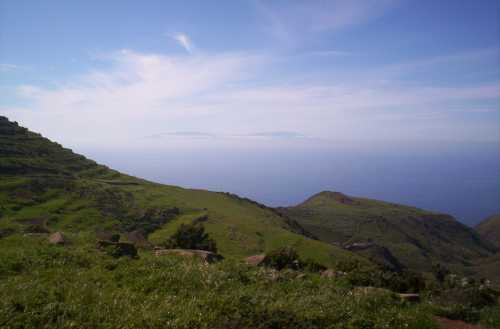Most people think quantum-mechanics affects only atomic-sized objects, but many experiments have shown that it applies over many miles. In an experiment last year, for example, researchers sent pairs of light particles, or photons, between two of the Canary Islands off the coast of Africa, a distance of 144 kilometers.

This picture dimly shows La Palma, where the photons started, as seen from Tenerife, where they were detected.
Although the Austrian team, led by Anton Zeilinger, only detected one in a million of the pairs they sent, they found that these pairs retained the critical property of entanglement. This means that results of measurements on the two particles are related in ways that can't be explained if each particle responds to the measurement independently: the pair acts like a single quantum-mechanical entity. Such pairs can be used to securely transmit information over long distances.
My latest story at Physical Review Focus describes a theoretical analysis of this experiment by researchers in Ukraine and Germany. They suggest that the pairs that survive the half-millisecond trip must have had unusually smooth sailing through the turbulent atmosphere, and that this is part of the reason why they are still entangled. (The motion of the air, like the shimmering of a mirage in the desert, generally disrupts the light transmission, but there are short moments of clarity.) This is a pretty comprehensible idea, so in the story I was able to sidestep a lot of interesting issues about how the entanglement was measured and what it means.
For example, the experimenters delayed one photon by about 50 ns by passing it through a fiber before sending it after the other one. That's not a long time, so the atmospheric conditions probably looked pretty similar to the two photons. Since they were subjected to much the same conditions, it doesn't seem so surprising that they would remain entangled. In fact, the original experimenters were pretty pleased that it all worked, but clearly they were hoping it might or they wouldn't have gone to the trouble.
Sending the two photons on the same path certainly isn't the most demanding task, either. More impressive would be sending them on different routes to a final destination where they were compared. But sending an entangled pair is good enough for some quantum communication schemes.
What made the paper particularly interesting was the conclusion that the turbulent atmosphere would be better than, say, an optical fiber that had the same average loss, because the fiber's properties wouldn't change with time. Zeilinger expressed pleasant surprise that the rare moments of exceptional clarity would more than make up for the times when the atmosphere was worse than usual. Still, having no turbulence at all (or a very clear fiber) would be even better.
Exploiting quantum mechanics in secure long-distance communication, for example via satellites, looks more realistic than ever.




No comments:
Post a Comment